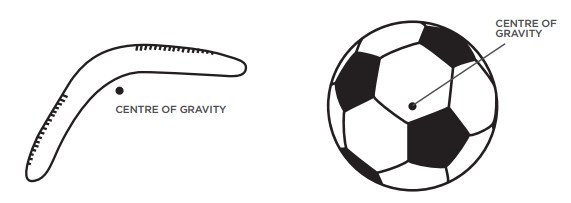Objectives
-
Identify ways in which balance affects our daily lives.
-
List the conditions required for an object to be stable.
-
Find an object’s centre of gravity.
Materials
Background
We sometimes use “centre of mass” and “centre of gravity” to mean the same thing. Technically, however, they are different. Centre of mass means “the average location of all the matter in an object”. The centre of gravity is the average location of the force of gravity on an object. They are only different, though, if the force of gravity is different on various parts of the object. How can that happen? The force of gravity gets weaker as you move away from the earth, so a very, very tall tower might have a slightly smaller force of gravity at the top than at the bottom.
For these activities: assume that we’re doing experiments with small objects close to the surface of the earth, so the centre of mass and centre of gravity are in the same place!
If an object has its weight distributed equally throughout, its centre of gravity is located at its geometric centre. If the object has an irregular shape, its centre of gravity may not be at its geometric centre. It is even possible for the centre of gravity to be entirely outside the physical boundaries of the object. The centre of gravity of a football, for example, is in the empty space inside the ball, and the centre of gravity of a boomerang is off to the side of its inner curve.

The centre of gravity of an object could also be called its balance point. If you support the centre of gravity, the object will balance. If an object is not supported directly below its centre of gravity then the object will topple over. This explains why a wide stance helps you keep your balance. As you move your centre of gravity (near your belly button) to and fro, it stays above your support (your feet). A tall object with a high centre of gravity and a skinny support will fall easily, because even a little sideways motion pushes the centre of gravity off the skinny support.
Vocabulary
balance(d) – A state in which opposing forces on an object reach equilibrium, so that the object is stable and not about to fall over.
centre of gravity – The mean location of the gravitational force acting on an object.
centre of mass – The mean location of all the mass in an object; a point that acts as if all the mass were centered there.
equilibrium – A state in which competing forces or influences are balanced and stable.
force – A push or a pull action on an object.
geometric centre – The physical middle of an object.
gravity – The force that attracts objects with mass down towards the centre of the earth.
mass – The amount of matter in an object, which stays the same regardless of what force(s) may be acting on it (i.e. 1 kilogram on Earth will be the same as 1 kilogram on the moon); measured in kilograms (kg). On Earth, “mass” and “weight” are often used interchangeably.
torque – Rotational or twisting force which occurs when an unstable object topples over.
weight – The force of gravity on an object, defined as mass (m) x acceleration due to gravity (a), measured in Newtons (N). An object weighing 10 Newtons on Earth will only weigh 1.6 Newtons on the Moon.
Other Resources
PhysicsLAB | Resource Lesson | Center of Mass
D’Art of Science | Balance Anything
The Royal Institute | Videos | Balancing Sculptures
Toy Maker | Balancing Butterfly
National Circus School of Canada
Robert Kramp: The Happy Scientist | Videos | The Science of Balance

